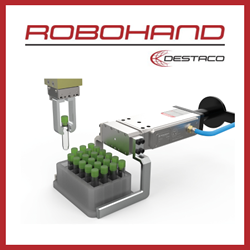Two new miniature absolute encoders join US Digital’s lineup
The MAE4 is a kit-style encoder designed to mount directly to existing shafts, while the MA4 is a shafted version. Both models deliver 12-bit resolution and offer a choice of analog or PWM outputs.
On April 29, 2025, US Digital announced the launch of two new miniature absolute encoders: the MAE4 and the MA4. The MAE4 is a kit-style encoder designed to mount directly to existing shafts, while the MA4 is a shafted version. Both models deliver 12-bit resolution and offer a choice of analog or PWM outputs.
For quick assembly, the MAE4 Magnetic Absolute Encoder Kit features US Digital's push-on magnetic hub which supports seven shaft diameters: four metric (3 mm, 4 mm, 5 mm, 6 mm) and three imperial (0.125", 0.188", 0.250") and two shaft lengths (0.220", 0.500"). It mounts to bolt circles of 0.750", 1.280", and 1.812", making it easy to integrate into existing or space limited applications.
Concerning the MA4 Shafted Miniature Absolute Encoder, US Digital's COO Neal Donowitz commented, "The MA4 being made from rugged glass-filled polymer makes it a great candidate for medical applications to meet their sterilization requirements." The MA4's shaft torque is also designed to provide the tactile feel of a potentiometer, ideal for manual front-panel interfaces.
Jim Stevens, US Digital's VP of Business Development pointed out that "several of these upgrades are a direct result of customer feedback."
The MAE4 and MA4 feature increased vibration and shock ratings and a latching connector to combine for a robust package and to be a dependable solution for industrial, medical, and other motion control applications.
All US Digital encoders are made in the USA, and most orders ship the same day.
Featured Product

DESTACO - Revolutionizing Industrial Automation
Looking for a reliable solution to enhance your automation process? Look no further than the DESTACO Robohand Grippers. These grippers are designed for the modern world of robotics, offering unparalleled performance and precision. Whether you need to grip fragile items, irregularly shaped objects, or heavy-duty components, the DESTACO Robohand Grippers have got you covered. Their modular design allows for quick and easy customization, ensuring a perfect fit for your application.
